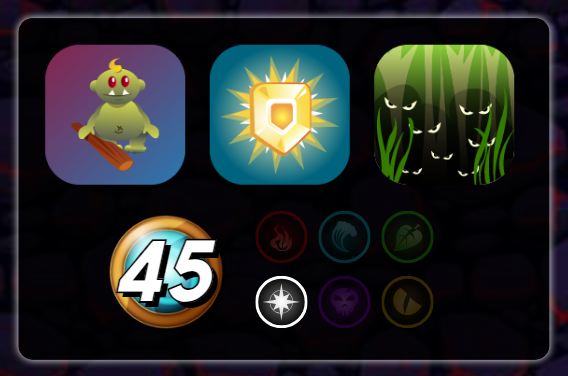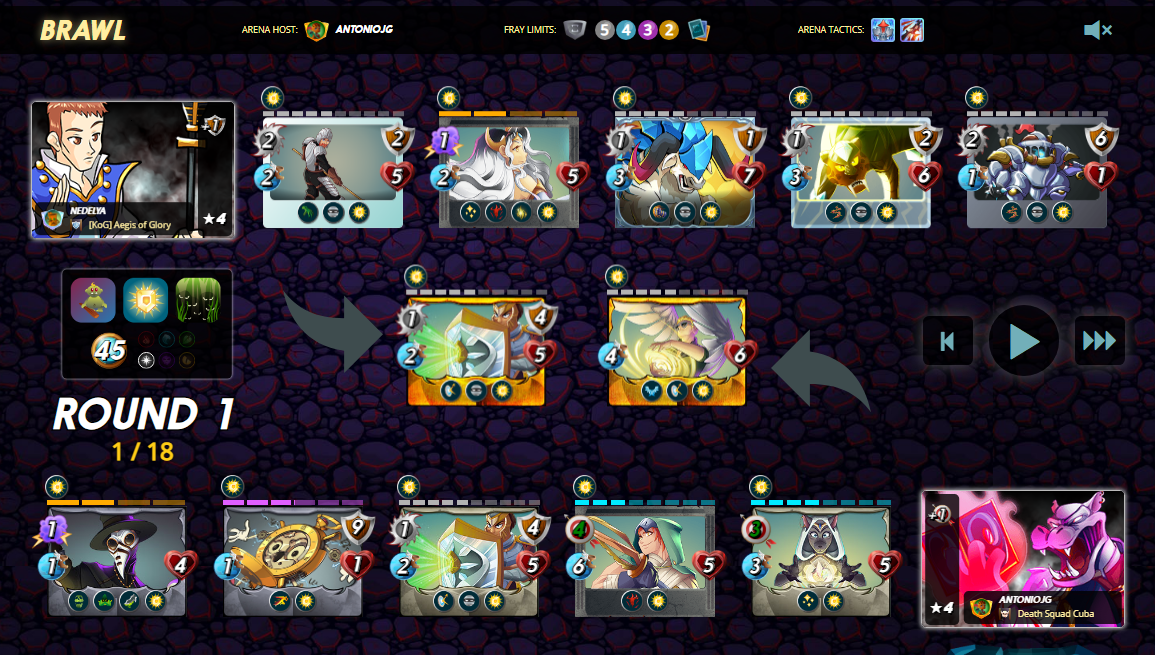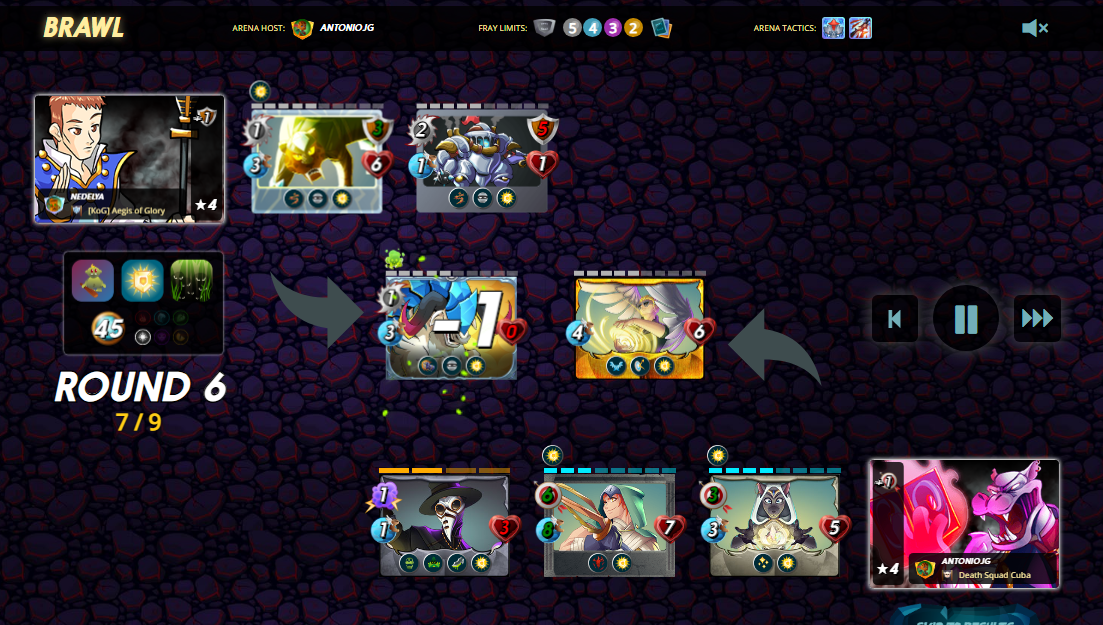
Español
¡Saludos comunidad! En el reto de esta semana quiero compartir con ustedes un análisis de mi experiencia utilizando una estrategia con el Splinter de Vida. La cual considero una excelente opción para aquellas partidas con un límite de maná alto y con las reglas de batalla “Super Sneak” & “Little League”. Es importante recordar que el tipo de ofensiva a utilizar en nuestras estrategias también dependerá del resto de reglas presentes en la batalla.
En esta oportunidad, les explicaré cómo afronté una batalla de Brawl de la liga de Plata en el formato Salvaje, enfocando mi análisis en explicar cómo utilicé al Splinter de Vida, el invocador General Sloan y a las unidades Pelacor Conjurer, Venari Crystalsmith, Ajax Lightfoot, Blinding Reflector, Clockwork Aide y Doctor Blight para ser coherente con las reglas de batalla presentes y las habilidades que quería combinar con la finalidad de tomar ventaja en la partida con la estrategia planteada.
Ya que estos aspectos son un factor clave con un impacto considerable en el desempeño de nuestras estrategias.

Conjunto de reglas y elección

Hablemos sobre el conjunto de reglas presentes en la batalla, este es el punto de partida para iniciar el análisis que nos llevará a la elección más adecuada para afrontar la batalla.
Límite de maná igual a 45 puntos, esta cantidad nos permite elegir invocadores con un costo de maná entre 4 y 7 puntos. Dejándonos con una cantidad de maná restante suficiente para elegir las unidades adecuadas.
“Little League”, es una regla que sólo permite utilizar invocadores y unidades con un coste de maná igual o menor a 4 puntos. Por otra parte, “Holy Protection”, otorga a todas las unidades la habilidad Divine Shield. Mientras que “Super Sneak”, otorga a todas las unidades de tipo melee, la habilidad Sneak.
Entonces, tomando en cuenta todos estos aspectos, decidí elegir al Splinter de Vida, ya que cuenta con unidades que poseen buenas estadísticas, entre ellas, un buen daño mágico y ranged. También cuenta con habilidades como: “Flying”, “Magic Reflect”, “Tank Heal”, “Bloodlust”, “Swiftness”, “Poison”, “Affliction”, entre otras y con un invocador que incrementa en 1 punto el ataque ranged del equipo.

Equipo y estrategia

Hablemos sobre el equipo y la estrategia que conforma. Dadas las circunstancias, era evidente el uso de cualquier tipo de ataque. Es por ello que decidí elegir al invocador General Sloan, ya que incrementa en 1 punto el ataque ranged del equipo.
Pelacor Conjurer fue el tanque en esta oportunidad, ya que cuenta con buenas estadísticas, entre ellas, sus puntos de velocidad y vida. Además, también posee las habilidades “Magic Reflect” y “Flying” que le permiten retornar parte del daño mágico recibido y aumentar su evasión ante ataques melee y ranged, respectivamente.
Venari Crystalsmith, además de contribuir con su ataque ranged, da soporte al tanque mediante la habilidad “Tank Heal”.
Ajax Lightfoot es una de las unidades claves en el equipo, ya que cuenta con la habilidad “Bloodlust”, la cual le permite incrementar considerablemente sus estadísticas, alcanzando un potencial increíble.
Blinding Reflector tiene el propósito de proteger a Ajax Lightfoot de los ataques Sneaks enemigos, dándole tiempo de alcanzar el potencial necesario.
Clockwork Aide tiene un objetivo similar al de Blinding Reflector con la diferencia que éste otorga cierta ventaja al equipo mediante la habilidad “Swiftness”, la cual incrementa en 1 punto la velocidad del equipo.
Doctor Blight es otra de las unidades clave, ya que se encarga de debilitar a las unidades enemigas a través de su ataque mágico y las habilidades “Poison” y “Affliction”.

Estrategia en acción

Como les mencioné anteriormente, elegir al invocador General Sloan y a las unidades Pelacor Conjurer, Venari Crystalsmith, Ajax Lightfoot, Blinding Reflector, Clockwork Aide y Doctor Blight, fue una buena opción. Sin embargo, también es importante incluir habilidades de soporte que le permitan a nuestro tanque y al resto del equipo, resistir lo suficiente.
Observen como para el turno 7 de la ronda 6, el equipo enemigo estaba casi abatido. Pelacor Conjurer resistió muy bien en la primera posición, mientras que Venari Crystalsmith, Ajax Lightfoot y Doctor Blight debilitaron al enemigo. Es importante destacar que Blinding Reflector y Clockwork Aide cumplieron su objetivo, permitiéndole al equipo alcanzar la ventaja planeada.
Si quieres ver la batalla completa, acá te dejo el enlace: CLIC PARA VER LA BATALLA

Conclusión
La estrategia planteada hizo un uso eficiente de la cantidad de maná disponible, cubriendo aspectos tales como: resistencia contra el daño enemigo, soporte del equipo, una buena ofensiva, y coherencia con el conjunto de reglas presente.
Una debilidad de esta estrategia es un equipo enemigo que cuente con resistencia al daño mágico y ranged e incluya habilidades de soporte como: “Protect”, “Repair”, “Tank Heal”, “Shield”, “Triage”, “Opportunity”, “Headwinds”, entre otras.
La diferencia entre las estrategias fue que la ofensiva del equipo enemigo no contaba con un daño muy elevado ni las habilidades de soporte suficientes, por lo que terminó siendo abatido.
Para el funcionamiento adecuado de nuestras estrategias, es importante considerar todos los aspectos involucrados, por lo que no sólo debemos enfocarnos en las estadísticas y habilidades a combinar. También debemos tener en cuenta la influencia de los conjuntos de reglas sobre la estrategia.
Este ha sido mi aporte al desafío semanal, ¡Espero haya sido de su agrado! ¡Saludos y hasta la próxima semana!

English
Greetings community! In this week's challenge I want to share with you an analysis of my experience using a strategy with the Splinter of Life. Which I consider an excellent option for those games with a high mana limit and with the battle rules “Super Sneak” & “Little League”. It is important to remember that the type of offensive to use in our strategies will also depend on the rest of the rules present in the battle.
In this opportunity, I will explain how I faced a Silver League Brawl battle in the Wild format, focusing my analysis in explaining how I used the Splinter of Life, the summoner General Sloan and the units Pelacor Conjurer, Venari Crystalsmith, Ajax Lightfoot, Blinding Reflector, Clockwork Aide and Doctor Blight to be coherent with the battle rules present and the abilities I wanted to combine in order to take advantage in the game with the strategy proposed.
Since these aspects are a key factor with a considerable impact on the performance of our strategies.

Rulesets and choise

Let's talk about the set of rules present in the battle, this is the starting point to begin the analysis that will lead us to the most appropriate choice to face the battle.
Mana limit equal to 45 points, this amount allows us to choose summoners with a mana cost between 4 and 7 points. Leaving us with a sufficient amount of remaining mana to choose the right units.
“Little League”, is a rule that only allows us to use summoners and units with a mana cost equal to or less than 4 points. On the other hand, “Holy Protection”, grants all units the Divine Shield ability. While “Super Sneak” grants all melee type units the ability Sneak.
So, taking into account all these aspects, I decided to choose the Life Splinter, since it has units with good stats, among them, good magic damage and ranged. It also has abilities such as: “Flying”, “Magic Reflect”, “Tank Heal”, “Bloodlust”, “Swiftness”, “Poison”, “Affliction”, among others, and a summoner that increases the team's ranged attack by 1 point.

Team and strategy

Let's talk about the team and its strategy. Given the circumstances, it was obvious to use any type of attack. That's why I decided to choose the General Sloan summoner, since it increases the team's ranged attack by 1 point.
Pelacor Conjurer was the tank in this opportunity, since he has good stats, among them, his speed and life points. In addition, he also has the “Magic Reflect” and “Flying” abilities that allow him to return part of the magic damage received and increase his evasion against melee and ranged attacks, respectively.
Venari Crystalsmith, besides contributing with his ranged attack, gives support to the tank through the “Tank Heal” ability.
Ajax Lightfoot is one of the key units in the team, since he has the “Bloodlust” ability, which allows him to considerably increase his stats, reaching an incredible potential.
Blinding Reflector has the purpose of protecting Ajax Lightfoot from enemy Sneak attacks, giving him time to reach the necessary potential.
Clockwork Aide has a similar purpose to Blinding Reflector with the difference that it gives the team a certain advantage through the “Swiftness” ability, which increases the team's speed by 1 point.
Doctor Blight is another key unit, since it is in charge of weakening enemy units through its magic attack and the “Poison” and “Affliction” abilities.

Strategy in action

As I mentioned before, choosing the summoner General Sloan and the units Pelacor Conjurer, Venari Crystalsmith, Ajax Lightfoot, Blinding Reflector, Clockwork Aide and Doctor Blight was a good choice. However, it is also important to include support abilities that allow our tank and the rest of the team to resist enough.
Note how by turn 7 of round 6, the enemy team was almost down. Pelacor Conjurer resisted very well in the first position, while Venari Crystalsmith, Ajax Lightfoot and Doctor Blight weakened the enemy. It is important to note that Blinding Reflector and Clockwork Aide fulfilled their objective, allowing the team to reach the planned advantage.
If you want to see the complete battle, here you have the link: CLICK TO WATCH THE BATTLE

Conclusion
The strategy proposed made an efficient use of the amount of mana available, covering aspects such as: resistance against enemy damage, team support, a good offensive, and coherence with the present set of rules.
A weakness of this strategy is an enemy team that has resistance to magic and ranged damage and includes support abilities such as: “Protect”, “Repair”, “Tank Heal”, “Shield”, “Triage”, “Opportunity”, “Headwinds”, among others.
The difference between the strategies was that the enemy team's offense did not have a very high damage or sufficient support skills, so it ended up being defeated.
For the proper functioning of our strategies, it is important to consider all the aspects involved, so we should not only focus on the statistics and skills to combine. We must also take into account the influence of the rule sets on the strategy.
This has been my contribution to the weekly challenge, I hope you enjoyed it, greetings and see you next week!

Te invito a seguirme en / I invite you to follow me on: Twitter
Las traducciones fueron realizadas con el traductor / Translations were done with the translator: DeepL
Todas las imágenes fueron tomadas de / and all images were taken from: Splinterlands
